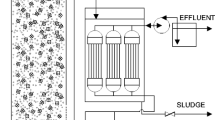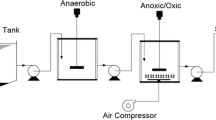Abstract
In recent years, moving bed systems have been shown as an efficient technology in wastewater treatment and particularly in the treatment of urban effluents. This paper presents the results obtained for three different carriers in organic matter removal, analysing the influence of hydraulic retention time (HRT) and the filling ratio, as well as the kinetic constants of each carrier used. During the research, differences in the organic matter removal were observed under different conditions studied as a result of physical and geometrical characteristics of each carrier and their hydraulic behaviour. Two of the three carriers studied in this research had similar yields compared to the third carrier that presented lower rates of organic matter removal and lower kinetic constants than the other two. Carriers 1 and 2 obtained removal rates of organic matter in the form of soluble chemical oxygen demand (sCOD) above 50% for intermediate and higher filling ratios with HRTs of 15, 10 and 15 h, respectively. The maximum values obtained for carrier 1, 2 and 3 were 56.97%, 58.92% and 46.13%, respectively, under 15 h of HRT and 50% of filling ratio. The kinetic constants obtained by respirometry showed a similar trend to the values obtained from sCOD removal.




Similar content being viewed by others
References
APHA. (1992). Standard methods for the examination of water and wastewater (18th ed.). Washington: American Public Health Association.
Chan, Y. J., Chong, M. F., Law, C. L., & Hassell, D. G. (2009). A review on anaerobic–aerobic treatment of industrial and municipal wastewater. Chemical Engineering Journal, 155(1–2), 1–18.
Falletti, L., & Conte, L. (2007). Upgrading of activated sludge wastewater treatment plants with hybrid moving-bed biofilm reactors. Industrial Engineering Chemical Research, 46(21), 6656–6660.
Ferrai, M., Guglielmi, G., & Andreottola, G. (2010). Modelling respirometric tests for the assessment of kinetic and stoichiometric parameters on MBBR biofilm for municipal wastewater treatment. Environmental Modelling & Software, 25, 626–632.
Gonzalez, S., Maldonado, L. E., & Gonzalez, O. (2002). Tratamiento de aguas residuals utilizando biopelícula sobre un material poroso. Cancún: XXVIII Congreso Internacional de Ingenieria Sanitaria y Ambiental.
Guibaud, G., Tixier, N., Bouju, A., & Baudu, M. (2003). Relation between extracellular polymers' composition and its ability to complex Cd, Cu and Pb. Chemosphere, 52(10), 1701–1710.
Helle, S. (1999). A respirometric investigation of the activated sludge treatment of BKME during steady state and transient operating conditions. Thesis. University of British Columbia.
Henze, M., Gujer, W., Mino, T., & Van Loosdrecht, M. C. M. (2000). Activated sludge models ASM1, ASM2, ASM2d and ASM3. London: IWA Publishing.
Jahren, S. J., Rintala, J. A., & Odegaard, H. (2002). Aerobic moving bed biofilm reactor treating thermomechanical pulping whitewater under thermophilic conditions. Water Research, 36, 1067–1075.
Judd, S. (2010). The MBR book. Principles and applications of membrane bioreactors for water and wastewater treatment. Oxford: Butterworth Heinemann.
Kermani, M., Bina, B., Movahedian, H., Amin, M. M., & Nikaein, M. (2008). Application of moving bed biofilm process for biological organics and nutrients removal from municipal wastewater. American Journal of Environmental Sciences, 4(6), 675–682.
Leiknes, T., & Ødegaard, H. (2007). The development of a biofilm membrane bioreactor. Desalination, 202, 135–143.
Mannina, G., & Viviani, G. (2009). Hybrid moving bed biofilm reactors: an effective solution for upgrading a large wastewater treatment plant. Water Science and Technology, 60(5), 1103–1115.
Mardani, Sh, Mirbagheri, A., Amin, M. M., & Ghasemian, M. (2011). Determination of biokinetic coefficients for activated sludge processes on municipal wastewater. Iranian Journal of Environmental Health Science & Engineering, 8(1), 25–34.
Marques, J. J., Souza, R. R., Souza, C. S., & Rocha, I. C. C. (2008). Attached biomass growth and substrate utilization rate in a moving bed biofilm reactor. Brazilian Journal of Chemical Engineering, 25, 665–670.
Mehrdadi, N., Azimi, A. A., Nabi Bidhendi, G. R., & Hooshyari, B. (2006). Determination of design criteria of an H-IFAS reactor in comparison with an extended aeration activated sludge processs. Iranian Journal of Environmental Health Science & Engineering, 3(1), 53–64.
Melin, E., Leiknes, T., Helness, H., Rasmussen, V., & Odergard, H. (2005). Effect of organic loading rate on a wastewater treatment process combining moving bed biofilm and membrane reactors. Water Science and Technology, 51(6–7), 421–430.
Monod, J. (1942). The growth of bacterial cultures. Annual Reviewer Microbiology 3, 371–394
Mulkerrins, D., Dobson, A. D. W., & Colleran, B. (2004). Parameters affecting biological phosphate removal from wastewaters. Environment International, 30, 249–259.
Odegaard, H., Rusten, B., & Westrum, T. (1994). A new moving bed biofilm reactor—applications and results. Water Science and Technology, 29, 157–165.
Pastorelli, G., Canziani, R., Pedrazzi, L., & Rozzi, A. (1999). Phosphorus and nitrogen removal in moving-bed sequencing batch biofilm reactors. Water Science and Technology, 40, 169–176.
Plattes, M., Henry, E., Schosseler, P. M., & Weidenhaupt, A. (2006). Modelling and dynamic simulation of a moving bed biorreactor for the treatment of municipal wastewater. Biochemical Engineering Journal, 32, 61–68.
Plattes, M., Henry, E., & Schosseler, P. M. (2008). A zero-dimensional biofilm model for dynamic simulation of moving bed bioreactor systems: model concepts, Peterson matrix, and application to a pilot-scale plant. Biochemical Engineering Journal, 40, 392–398.
Powell, E (1972). Hypertrophic Growth. Journal of Applied Chemistry and Biotechnology, 22(1), 71–78
Ramalho, R. S. (2003). Tratamiento de aguas residuales. Sevilla: Editorial Reverté S.A.
Rodriguez, F. A., Poyatos, J. M., Reboleiro-Rivas, P., Osorio, F., González-López, J., & Hontoria, E. (2011). Kinetic study and oxygen transfer efficiency evaluation using respirometric methods in a submerged membrane bioreactor using pure oxygen to supply the aerobic conditions. Bioresource Technology.
Rusten, B., Kolkinn, O., & Odegaard, H. (1997). Moving bed biofilm reactors and chemical precipitation for high efficiency treatment of wastewater from small communities. Water Science and Technology, 35(6), 71–79.
Rusten, B., Eikebrokk, B., Ulgenes, Y., & Lygren, E. (2006). Design and operations of the Kaldnes moving bed biofilm reactors. Aquacultural Engineering, 34, 322–331.
Sriwiriyarat, T., & Randall, C. W. (2005). Performance of IFAS wastewater treatment processes for biological phosphorus removal. Water Research, 39(16), 3873–3884.
Sun, C., Leiknes, T., Weitzenböck, J., & Thortensen, B. (2009). The effect of bilge water on a Biofilm–MBR process in an integrated shipboard wastewater treatment system. Desalination, 236, 56–64.
Trapani, D. D., Mannina, G., Torregrossa, M., & Viviani, G. (2010). Quantification of kinetic parameters for heterotrophic bacteria via respirometry in a hybrid reactor. Water Science and Technology, 61(7).
Tyagi, R. D., & Vembu, K. (1990). Wastewater treatment by immobilized cells. Boca Raton: CRC Press.
Wang, R., Wen, X., & Qian, Y. (2005). Influence of carrier concentration on the performance and microbial characteristics of a suspended carrier biofilm reactor. Process Biochemistry, 4, 2992–3001.
Welander, U., Henrysson, T., & Welander, T. (1998). Biological nitrogen removal from municipal landfill leachate in a pilot scale suspended carrier biofilm process. Water Research, 32(5), 1564–70.
Xing, X., Jun, B., Yanagida, M., Tanji, Y., & Unno, H. (2000). Effect of C/N values on microbial simultaneous removal of carbonaceous and nitrogenous substances in wastewater by single continuous-flow fluidized-bed bioreactor containing porous carrier particles. Biochemical Engineering Journal, 5, 29–37.
Zhang, C., Tezel, U., Li, K., Liu, D., Ren, R., Du, J., et al. (2011). Evaluation and modeling of benzalkonium chloride inhibition and biodegradation in activated sludge. Water Research, 45, 238–246.
Acknowledgements
This research was supported by the Spanish Ministerio de Ciencia y Tecnología (MCyT) under project reference CTM2009-11929-C02-01 and by University of Granada by a personal grant to J. Martín-Pascual. This research was also made possible thanks to the participation of the following companies: EMASAGRA, ESAMUR ECOHIDRO and CYCLUS.
Author information
Authors and Affiliations
Corresponding author
Rights and permissions
About this article
Cite this article
Martín-Pascual, J., López-López, C., Cerdá, A. et al. Comparative Kinetic Study of Carrier Type in a Moving Bed System Applied to Organic Matter Removal in Urban Wastewater Treatment. Water Air Soil Pollut 223, 1699–1712 (2012). https://doi.org/10.1007/s11270-011-0976-5
Received:
Accepted:
Published:
Issue Date:
DOI: https://doi.org/10.1007/s11270-011-0976-5




